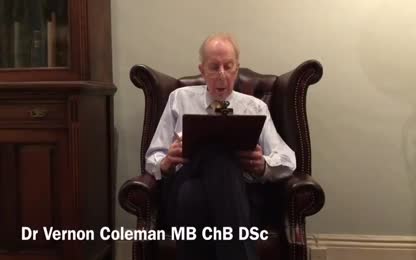Advertisement
Beware of Medical Fads and Fashions - Coleman’s 7th Law of Medicine
Beware of Medical Fads and Fashions - Coleman’s 7th Law of Medicine
https://www.vernoncoleman.org
Dr Vernon Coleman’s book, ’How to Stop Your Doctor Killing You’ is available here https://www.vernoncoleman.org
Dr Vernon Coleman’s book, ’How to Stop Your Doctor Killing You’ is available here https://www.amazon.co.uk/How-Stop-Your-Doctor-Killing/dp/1795176598/
- Category: Big Pharma /FDA Approved /CDC,Book/Novel/Biography/Poetry,Experience
- Duration: 08:49
- Date: 2021-08-25 21:32:48
- Tags: no-tag
2 Comments
Video Transcript:
There are fashions in medicine just as much as there are fashions in clothes. The difference is that whereas badly conceived fashions in clothes are only likely to embarrass you, ill-conceived fashions in medicine may kill you. The fashions in medicine have by-a-large as much scientific validity as the fashions in the clothes industry, and so my seventh law of medicine is to try to be aware of medical fads and fashions. The most obvious fashions in medicine relate to treatments. For example, a couple of centuries ago, enemas, purgis and bleedings were all the rage. In 17th century France, Louis XIII, had two hundred and twelve enemas, two hundred and fifteen purgis and forty-seven bleedings in a single year. The canon of Troyes is reputed to have had a total of two thousand one hundred and ninety enemas in a two-year period. How he found time to do anything else is difficult to imagine. By the mid-nineteenth century, enemas were a little last year's style and bleeding was the in-thing. It was even a posh word for it. Doctors who were about to remove blood from their patients would say that they were going to flabotterize them. Patients would totter into the doctor's surgery, sit down, tuck up their sleeves and ask a doctor to draw me a pint of blood. Painting was the universal cure recommended for most symptoms and ailments. Feeling a little under the weather, a little light bleeding should soon put you to rights. Constant headaches will soon have that sorted out for you, so just roll up your sleeve. Bit of trouble down below madam? Not to worry, hold your arm out. A little later in the nineteenth century, doctors put their lanceets away and started recommending alcohol as the new panacea. Brandy was the favourite remedy and the doctor's pharma capya, people took it for almost everything. And when patients became alcoholics, the recommended treatment was more alcohol. If things got so bad that the brandy didn't work, doctors added a little opium. Those were the days to be ill. Hyperconjurex must have had a wonderful time. In the years from the 1930s onwards, removing tonsils became the fashionable treatment. Tonsils were removed from between a half and three quarters of all children in the 1930s. This often useless and unnecessary and always potentially hazardous operation is less commonly performed these days, but in the 70s over a million such operations were done every year in Britain alone. Doctors used to repart tonsils on the kitchen table and toss them to the dog. Between 200 and 300 deaths a year were caused by the operation. One suspects that few, if any, of those unfortunate children would have died from tonsilitis. Diseases go in cycles too. One year everyone will be suffering from asthma. It will be the disease of the moment, just as the miniscirt or ripped jeans made drift mysteriously in and out of fashion. Another year, arthritis will be the fashionable disease as a drug company persuades journalists to write articles extolling the virtues and disguising the vices of its latest product. The cycles are relatively simple one. The drug company with a new and profitable product to sell, usually designed for some long term and therefore immensely profitable disorder, will send teens of well-trained representatives around to talk to family physicians, give them presents and take them out for expensive lunches. The sales reps will be equipped with information, showing that the disorder in question is rapidly reaching epidemic proportions. This is a warning system for the doctor to watch out for an information about the drug company's new solution to the problem. Because the product will be new to the market, there will probably be very little evidence available about side effects and the sales representative will be accurately able to describe the drug as extremely safe. And the number of prescriptions being written for the new one the product will soon rock it, pushing up drug company profits dramatically. Then a year or so later patients and doctors alike will become aware of the many side effects associated with the new alleged wonder product and prescribing levels will fall. It's then the turn of some other product and some other disease to take the limelight and some other drug company to enjoy a dramatic boost in its profits. For years now surgeons have been performing unnecessary operations, operations which have done far more harm than good. It is of course difficult to be precise about the number of unnecessary operations, but in America researchers have concluded that in an average sort of year surgeons working in American hospitals now perform seven and a half million unnecessary surgical procedures, resulting in nearly 40,000 unnecessary deaths and a cost running into hundreds of billions of dollars. One American Congressional Committee found that 17.6% of recommendations for surgery were not necessary. Nothing illustrates the uselessness and danger of elective surgery more completely than heart surgery. In America having had at least one coronary artery bypass operation is as much a sign of success as ownership of a Mercedes limousine and the operation is growing in popularity around the rest of the world, in Britain around 10% of the people who have had heart attacks end up having bypass operations. Many surgeons claim that surgery for heart disease isn't elective but vital, but the evidence shows that most of the surgery performed for the treatment of heart disease is entirely unnecessary. Back in 1988, in a now-out-of-print book called The Health Scandal, I reported that coronary artery bypass surgery, the commonest procedure performed in cardiac surgery, had been in use for nearly 30 years then, without anyone trying to find out how patients everyday lives were affected by the operation. When a surgery was eventually done, when a survey was eventually done, it was found that whereas nearly half of the patients who had the operation had been working right up to the time of surgery, three months after the operation only just a third of the people were working and a year after the operation nearly half the patients were still not working. In other words, the operation had little positive effect on patients' lives, but did put a good many out of action for some time, and there were, of course, a number of patients who died as a result of surgical complications. And what makes the medical profession's enthusiasm for coronary artery surgery even more bizarre is the fact that patients who have symptoms of heart disease often don't need surgery at all, but stand a better chance of recovering if they put on a regime which includes a vegan diet, gentle exercise and relaxation. I described the utterly convincing evidence for this in my book How to Stop You Dr. Killing You, which was first published in 1996, the chapter is called How to Conquer Heart Disease Without Pills or Surgery. The vast majority of medical journalists who might be expected to criticize unnecessary medical procedures which put patients' lives at risk, no little or nothing of medical matters, and are too much in awe of the medical establishment to offer any sort of criticism. Psychologists and psychologists are also eager to create fashionable new bandwagons. It's now possible to be clinically afraid of over 500 different things, for that's the astonishing number of phobias which have been officially recognized. In addition to traditional phobias, such as claustrophobia, patients can now suffer from a fear of defeat, a fear of infinity, a fear of money and a fear of long words. It's difficult to tell when the psychiatrists are being serious and when they're having a zone. Those are real phobias. Other companies exaggerate mild problems in order to boost their profits, of course, and they devise and then promote non-existent diseases in order to create fashionable new markets for their drugs. Hence Coleman's seventh law of medicine. Beware of medical fads and fashions. Please visit my video channel on brand YouTube. For the record, none of my videos has ever been monetized. Please visit my websites for nacomand.com and vernicomand.org. Thank you for watching an old man in a chair.










 Donate
Donate







